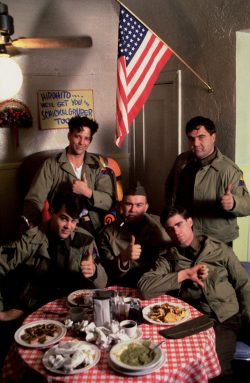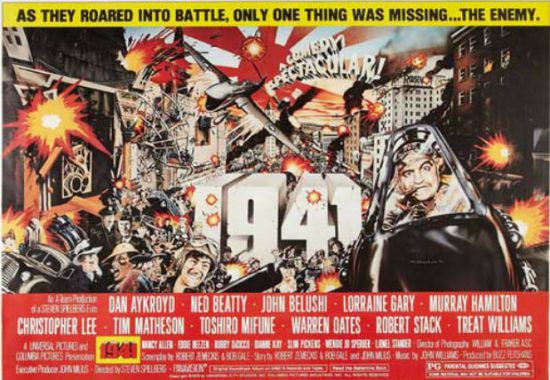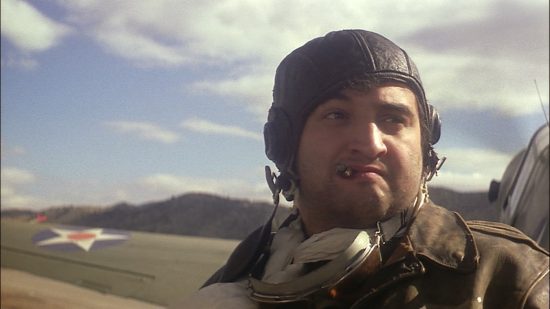SpielBLOG: 1941 – A Steven Spielberg Retrospective
Stanley Kubrick said it should have been marketed as a drama. John Milius saw it as an opportunity to make a historical film about a general to rival Patton. Steven Spielberg admitted he might have been better off making the film as a musical. On one thing everyone seems to agree. 1941 didn’t work as a comedy.
February 23rd, 1942: a lone Japanese submarine I-17 opened fire with its deck gun on the Ellwood Field Oil Refinery, near Santa Barbara, California. The next night the guns above Los Angeles opened fire on what some later claimed was an errant weather balloon, others a UFO but – in the jittery state since the Pearl Harbor attack two months ago – was believed at the time to be an enemy aircraft. The city was blacked out and the affair when down in the annals of mass panic and became the inspiration for two screenwriters Bob Gale and Robert Zemeckis to write what would become Steven Spielberg’s fourth feature film: 1941.
On paper everything made sense. Spielberg had made two genre-defining movies – horror and sci-fi – and invented the tent pole blockbuster in the process. The script was solid and had the stamp of approval of John Milius, who got a story credit. And the cast was great; mixing iconic character actors like Christopher Lee, Ned Beatty and Slim Pickens with Saturday Night Live regulars: Dan Aykroyd and John Belushi. Spielberg continued his habit of collecting foreign film icons. After Truffaut in Close Encounters, legendary Japanese actor and Kurosawa’s close collaborator Toshiro Mifune appears as the commander of the submarine. A young Mickey Rourke can also be spied as part of Aykroyd’s tank crew. These were his blink-and-you’ll-miss-him years.
 Moving the action earlier to New Year’s Eve, the film also conflates the two events along with the Zoot Suit riots into one madcap night. The result is an orgy of cartoonish destruction, which is only rarely funny. It reminded me a lot of The Hudsucker Proxy, an over-directed, breathless attempt to pastiche screwball comedy while never getting to the verbal heart of the genre. The sub-Porkys subplot of Tim Matheson trying to get into Nancy Allen’s bloomers by getting her up in a plane feels turgid even by the standards of the time. Re-watch National Lampoon’s Animal House for more rapey comedy. Belushi’s star role as ‘Wild’ Bill Kelso, the aviator who ends up strafing the airborne bonkers, is a one-note piece of bluster that must have been funny if you’re on cocaine. A lot of cocaine.
Moving the action earlier to New Year’s Eve, the film also conflates the two events along with the Zoot Suit riots into one madcap night. The result is an orgy of cartoonish destruction, which is only rarely funny. It reminded me a lot of The Hudsucker Proxy, an over-directed, breathless attempt to pastiche screwball comedy while never getting to the verbal heart of the genre. The sub-Porkys subplot of Tim Matheson trying to get into Nancy Allen’s bloomers by getting her up in a plane feels turgid even by the standards of the time. Re-watch National Lampoon’s Animal House for more rapey comedy. Belushi’s star role as ‘Wild’ Bill Kelso, the aviator who ends up strafing the airborne bonkers, is a one-note piece of bluster that must have been funny if you’re on cocaine. A lot of cocaine.
The funniest acting actually comes from Robert Stack as General Stilwell, whose withering common sense could have done with being the center of the film. The role incidentally was offered to both John Wayne and Charlton Heston who both rejected it on the ground that the film was anti-American, something Spielberg found difficult to grasp. For him, it was a jape.
And to be fair, especially as the chaos lets loose in the latter half of the film, 1941 becomes a lot of fun. The destruction on display isn’t funny as such but a tank driving through a paint factory is a beautifully exhilarating sight. As are the shots of Belushi’s fighter plane flying through Hollywood Boulevard like it was a trench on the Death Star.
It’s kind of funny what Spielberg finds funny. Ned Beatty gleefully destroying his own house in order to hit the submarine with the big gun carries on the Roy Neary-need for domestic destruction. The fight between the navy and the army is as musical as the dance scene that precedes it. The influence of Martin Scorsese’s New York, New York from two years before can be felt, though Spielberg obviously didn’t heed the warnings. Francis Ford Coppola – not to be outdone – would sink Zoetrope studios with One from the Heart in 1982.
There’s a confidence here that borders on and actually invades hubris. The opening scene is a shot-for-shot parody of the opening of Jaws, with the same actress Susan Backlinie now having her skinny-dipping interrupted by a Japanese periscope. The gas station lady from Duel Lucille Benson reprises her role also. This self-referential stuff smacked of someone beginning to believe their own press and on top of that he was becoming a bit of a control freak, directing second unit and miniature stuff and eating up time and money in the process.
None of this would have mattered if the film had been the blockbuster the poster seemed to announce. It wasn’t a flop but as Pauline Kael had warned Spielberg privately – ‘We’re all waiting for you to fail’ – and not having a blockbuster was – for this young director – tantamount to failure.
There are many lessons from 1941 that Spielberg would revisit. In fact, his next film would also have an intense nostalgia for the 40s, along with an unreconstructed view of the racism of the time. The joke Christopher Lee plays with a torture instrument becoming a coat hanger and Treat Williams’ macho man with one particular fear – for eggs!? – would both be retooled for the next film. But more than anything the new film would put down a marker that Spielberg could bring in a picture with the efficiency of the old school studio system, rather than the inflated bombast of his faltering contemporaries.
That film would be Raiders of the Lost Ark.
You can check out my blog and follow me on Twitter.











